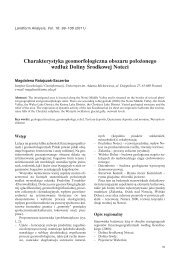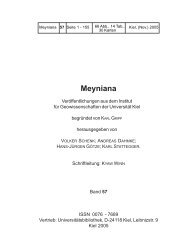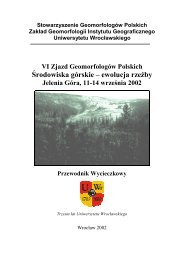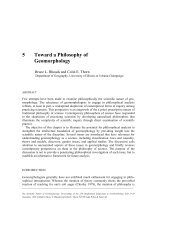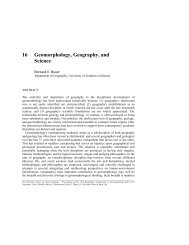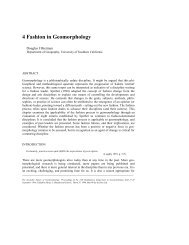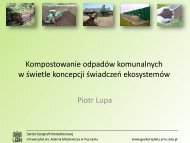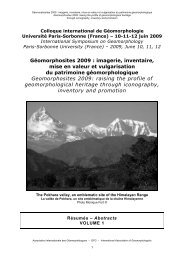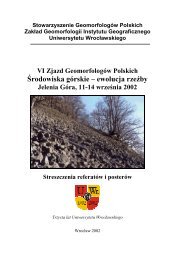Physical Modelling in Fluvial Geomorphology
Physical Modelling in Fluvial Geomorphology
Physical Modelling in Fluvial Geomorphology
You also want an ePaper? Increase the reach of your titles
YUMPU automatically turns print PDFs into web optimized ePapers that Google loves.
226 SCIENTIFIC NATURE OF GEOMORPHOLOGY<br />
The second example of movable-bed modell<strong>in</strong>g is complicated by the additional<br />
consideration of sediment transport.<br />
Fixed-bed modell<strong>in</strong>g (case without mobile sediment)<br />
In order to use dimensional analysis, the quantities that control a given system must first<br />
be selected and expressed <strong>in</strong> terms of their fundamental units. For open channel flow with<br />
a fixed bed, these controll<strong>in</strong>g variables are usually taken as (Yal<strong>in</strong> 1971):<br />
• properties of the fluid - the dynamic viscosity (µ) and density (ρ)<br />
• boundary conditions of the channel, normally hydraulic radius (R) and surface<br />
roughness (ks)<br />
• bed slope (S)<br />
• average downstream velocity (U) and<br />
• gravitational constant (g)<br />
Three govern<strong>in</strong>g variables must be chosen to obta<strong>in</strong> a solution from these seven<br />
variables (µ, ρ, R, ks, S, U and g) us<strong>in</strong>g dimensional analysis. These pr<strong>in</strong>cipal variables are<br />
generally taken as ρ, R and U s<strong>in</strong>ce they generate two key flow parameters, the Froude<br />
and flow Reynolds numbers. The method generates n - 3 dimensionless terms where n is<br />
the number of variables and 3 is the number of govern<strong>in</strong>g variables. These are referred to<br />
as 'pi' (Π) terms. In the example considered here, four terms are produced:<br />
The four Π terms represent the flow Reynolds number (Π1), the Froude number (Π2),<br />
the relative roughness (Π3) and the channel bed slope (Π4). If the ratio between prototype<br />
and model is kept identical for all four of these terms, the model would be an exact<br />
representation of the prototype. However, this situation is rarely atta<strong>in</strong>able <strong>in</strong> hydraulic<br />
modell<strong>in</strong>g as illustrated by consider<strong>in</strong>g the Froude and Reynolds numbers. S<strong>in</strong>ce water is<br />
used <strong>in</strong> most experimental studies, the density and viscosity of the fluid are the same <strong>in</strong> the<br />
model (m) and prototype (p), assum<strong>in</strong>g a constant temperature, and therefore the Reynolds<br />
number can be rearranged to give<br />
UpRp = UmRm<br />
(5)<br />
and therefore<br />
where λu is the scal<strong>in</strong>g ratio of velocity.<br />
∏<br />
∏<br />
∏<br />
∏<br />
λ<br />
1<br />
u<br />
2<br />
3<br />
4<br />
ρRU<br />
= = Re<br />
µ<br />
=<br />
ks<br />
=<br />
R<br />
= S<br />
U<br />
= Fr<br />
gR<br />
U R<br />
= =<br />
U R<br />
m<br />
p<br />
p<br />
m<br />
(1)<br />
( 2)<br />
( 3)<br />
( 4)<br />
( 6)



